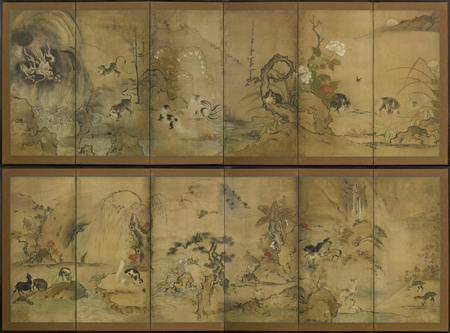Product Description
6254/55 A pair of six-fold paper screens painted in ink and colour on a buff ground with various animals in a river landscape
Japan 16th century Muromachi/Momoyama period
Dimensions: H. 110cm x W. 294cm (43½” x 116”) each
This unusual pair of screens depict various animals and beasts both real and imaginary coexisting in a natural landscape filled with various flowers and plants.
The animals depicted here are: deer, horses, goats, qilin (kirin), weasel, oxen, hares, wild cat, monkeys, civets, tigers and dragon. The choice of animals seems rather random however it was probably intended to portray a utopia. Mythical and exotic beasts are included, each is painted in an ideal manner with some motifs based on Chinese paintings. The way many of these animals are portrayed in pairs, playful groups and families also suggests auspicious connotations within the painting with a wish of prosperity for the owners.
Qilin (Japanese kirin) first appeared in Chinese mythology. This Asian version of a unicorn has either one or two horns on its head, a yellow belly, a scaly multicoloured back, the hooves of a horse, the body of a deer, and the tail of an ox. Gentle of disposition, it never walks on verdant grass or eats living vegetation and its rare appearance is said to often coincide with the imminent birth or death of a sage or an illustrious ruler. The name qilin is a combination of the Chinese characters qi and lin meaning male and female. In Japan the qilin retains the same qualities as on the main land and is also a symbol of authority with the perspicacity to bring criminals to justice. Due to these beliefs the qilin along with other auspicious symbols such as the phoenix, bamboo and paulownia often appeared as a design motif on the robes of Japanese emperors.
The Eastern dragon is not the gruesome monster of medieval imagination, but the genius of strength and goodness. He is the spirit of change, therefore of life itself. Hidden in the caverns of inaccessible mountains, or coiled in the unfathomed depths of the sea, he awaits the time when he slowly rouses himself into activity. He unfolds himself in the storm clouds; he washes his mane in the blackness of the seething whirlpools. His claws are in forks of lightening; his scales begin to glisten in the bark of rain-swept pine trees. His voice is heard in the hurricane, which, scattering the withered leaves of the forest quickens a new spring.
In the traditional cosmology of China the dragon is one of the Four Sacred Creatures, it represents the east, spring and water. It is thus the compliment of the tiger, which represents the west, autumn and wind. The interaction of the two, the play of water and wind – is thought vital for creating weather that makes soil fertile and crops prosper.
The tiger is a symbol of strength, courage and longevity and is also accredited with the ability to fend off demons, ill-fortune and disease. Japan’s artistic treatment of tigers is usually highly stylised. With no indigenous specimens to study, artists of the pre-modern period constructed their notions of the tiger from skins imported into the country. This has resulted in a rather cat-like depiction of this noble feline beast.
Likewise, civets did not inhabit Japan however they were regarded as graceful, somewhat sacred creatures. Artists of the time are believed to have studied some familiar animals like cats and dogs as basic models, referred to the paintings from China and added imaginary features to illustrate the exotic animals that they had never seen in real life.
There are some early paintings from the 16th century portraying civets in a comparable manner. Two civets with fluffy tails can be found on a set of fusuma (sliding door) ‘peonies and civets’ executed by Kano School artists in 1586, currently housed in the Nanzenji temple, Kyoto (Important Cultural Property).
A pair of screens attributed to Kano Utanosuke Yukinobu (act. early 16th century), one of the pair housed in the Museum of Fine Arts Boston (accession no. 11.6781) and the other half housed in the Suntory Museum of Art in Tokyo, depict civets and pine in a similar way as those in the present pair. See Suntory Museum of Art et.al. eds., Biombo: Japan Heritage as Legend of Gold, (Japan, 2007), p.248-49, pl.100, 101; Kyoto National Museum ed., The Kano School in the Muromachi Period: On the Road to Artistic Predominance, (Japan, 1996), p.178-88, no.107.
The group of horses are similar in treatment to those mentioned in Bijutsu Gaho (The Magazine of Art) XVIII, No.8, issued on 20 January 1906, which refers to a pair of screens depicting wild horses by Kano Utanosuke Yukinobu in the collection of Baron Kuki Ryuichi.
Other similar depictions of horses can be found on a pair of screens ‘Pasturing Horses’ painted by Hasegawa Tohaku (1539-1610) in his early career, currently in the collection of Tokyo National Museum. See Tokyo National Museum et.al. eds., Screen Paintings of the Muromachi Period: A Special Exhibition Held to Commemorate the 100th Anniversary of Kokka Magazine, (Tokyo, 1989), p.192-193, no. 77. Another comparable pair of screens depicting horses attributed to Kano Sanraku (1559-1635) are housed in the Corfu Museum of Asian Art, Greece.















